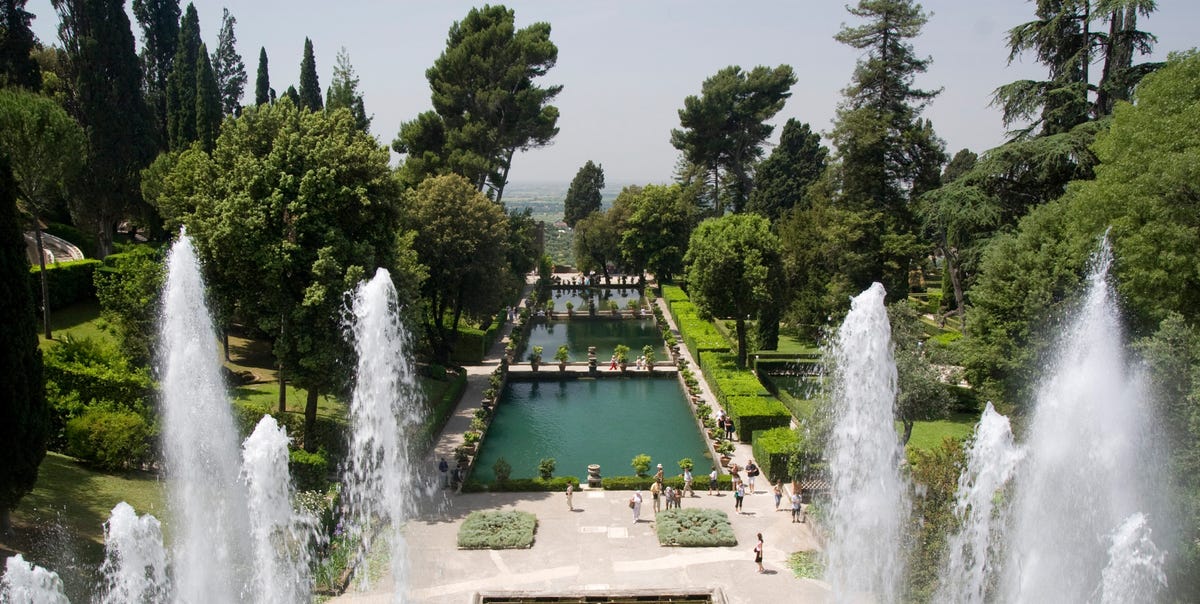Villa d’Este, Tivoli, Italy
Just a one-hour train ride from Rome, the Villa d’Este was the 16th-century home of Cardinal Ippolito II d’Este. As he built his estate he transported stones and statues from the remnants of a nearby villa that had been the summer home of the ancient Roman emperor Hadrian. The cardinal tapped Pirro Ligoria, an architect and classical scholar, to design the property’s palace and surrounding terraced gardens. A walk through these hillside gardens is a lesson in Italian Renaissance engineering, with hundreds of spouts and fountains, often in the form of grotesques, cascading down steps and through decorative canals before feeding into manmade pools. The views are magnificent, with the historic town of Tivoli visible in the distance through hedges, moss covered caves, and Roman pine trees.
Jardin Majorelle, Marrakech, Morocco
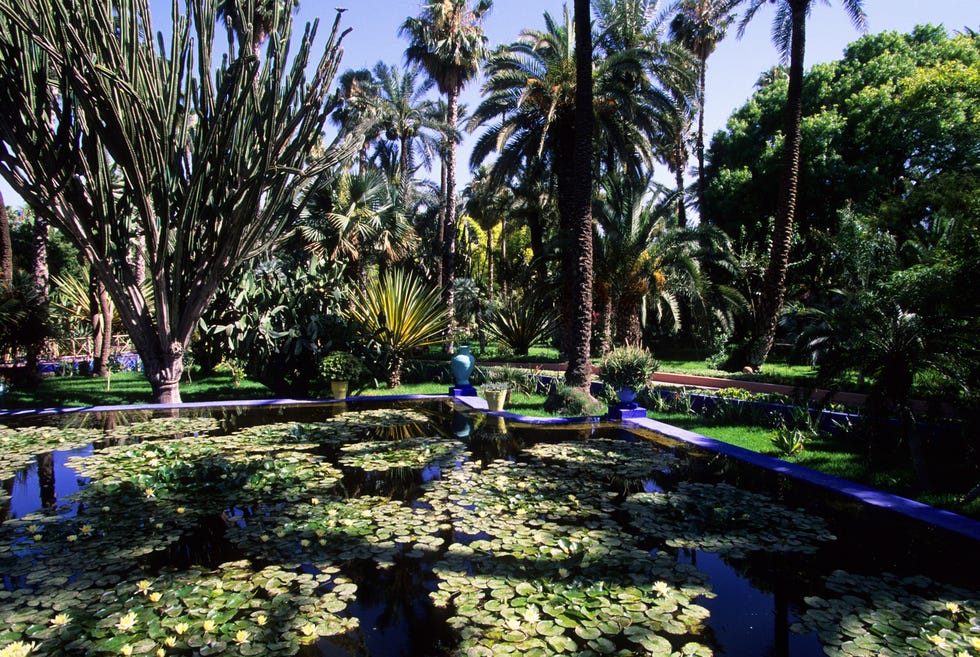
In the 1920s, the French artist Jacques Majorelle designed a two-acre garden in Marrakesh, Morocco, to capture his idea—call it a fantasy—of the look and feel of “the Orient.” Regardless of the fictive nature of his creation, there is still true beauty in his work. Most of the garden and villa are drenched in a striking shade of cobalt blue now called Majorelle, a color the artist picked up from the Tuareg people’s indigo-dyed garments. After Yves Saint-Laurent and Pierre Bergé bought the property in the 1980s, it became a destination for the world’s fashion and art elite. Now anyone can visit and enjoy the garden’s cacti and native flora, and the primary-hued villa, which now houses a collection of Berber artifacts.
Advertisement – Continue Reading Below
Haga Park, Solna, Sweden
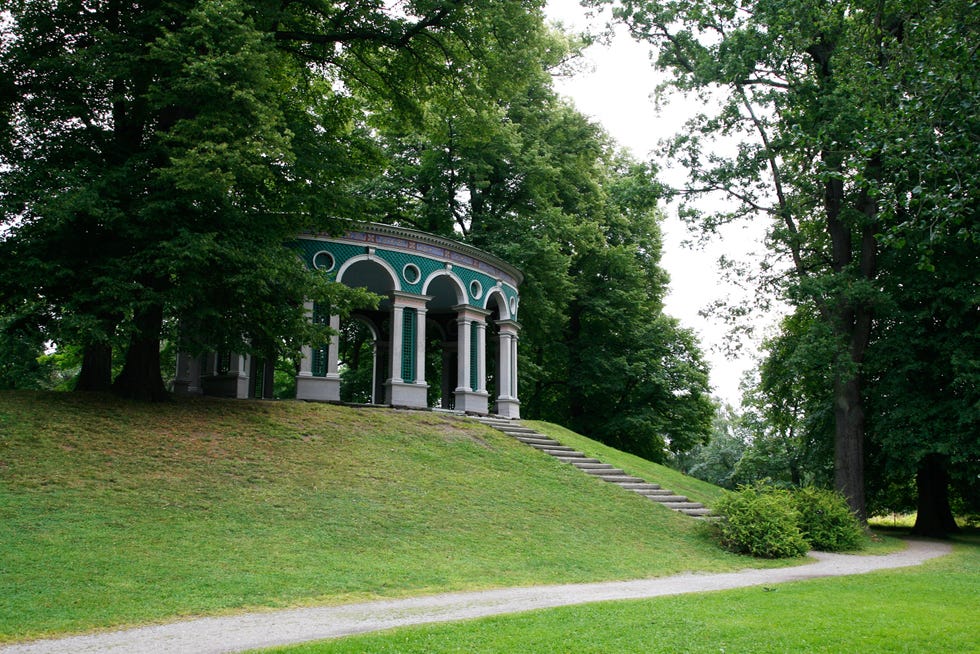
Gustav III, an 18th-century Swedish king, sought balance, equanimity, and beauty in all things. So he built a pavilion north of Stockholm in Haga Park: a pastel-hued neoclassical respite tucked inside the park’s gardens. The humanist philosophy that guided most of his decisions—emphasizing the innate value of every human being and the value of human creation—also influenced how he wanted to live: with and around nature’s bounty. The nearby palace, built between 1802 and 1805 by his son Gustav IV Adolf, came later. The surrounding gardens, now part of Sweden’s Royal National City Park, complete the fairy tale with several follies and English-style plantings that encourage moments of contemplation. Between quiet ponds and old oak trees you can spy Louis Jean Desprez’s Ottoman-inspired copper tents, originally intended as housing for the royal guard. In 1989 the Fjärilshuset (“Butterfly House”) was added to the property, an indoor nature preserve where hundreds of types of butterfly flutter about, offering a less historical but equally magical experience.
Las Pozas, Xilitla, Mexico
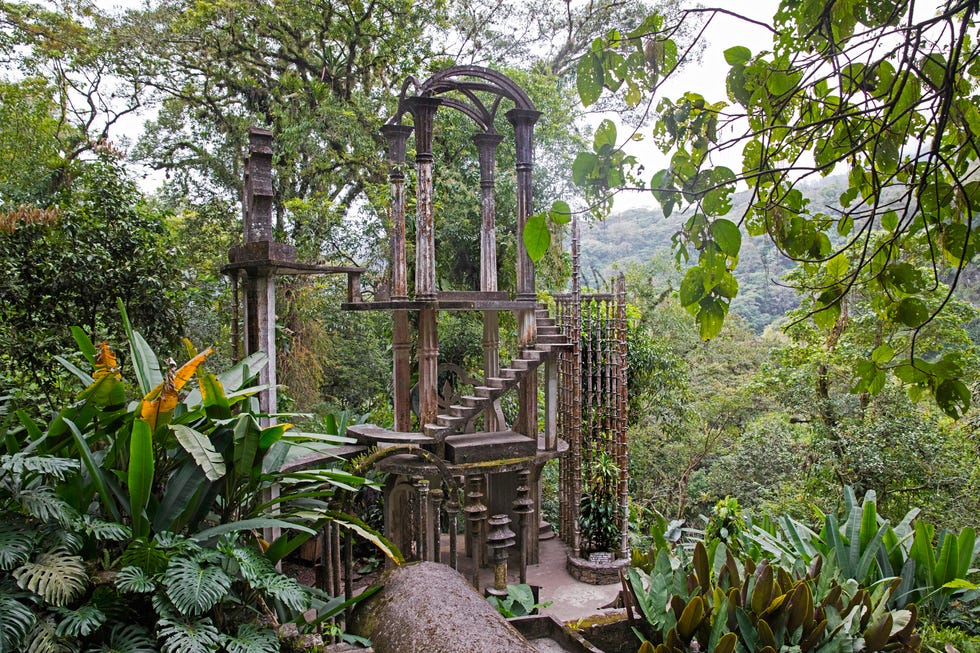
We have all seen a Surrealist sculpture or painting, but how many can say they’ve visited a Surrealist garden? One such place exists in the hills of Xilitla, on the east side of the Sierra Gorda mountains – a two-hour drive from Ciudad Valles. Designed by British poet Edward James, Las Pozas features a series of architectural follies, including stairs that lead nowhere and columns that support nothing, all nestled inside a wild, overgrown subtropical rainforest. The project took a long time, as the weathered and varied structures within it show. James began designing the follies in 1949, building them with the help of local craftsmen, and didn’t stop until 1984. He collaborated with exceptionally skilled Mexican artists to build the garden and collaborated on its design with a local guide, Plutarco Gastélum Esquer, who later became a close intimate of James. It’s a garden of dreams, literally, melding the natural with the manmade to stunning effect.
Advertisement – Continue Reading Below
Boboli Gardens, Florence, Italy
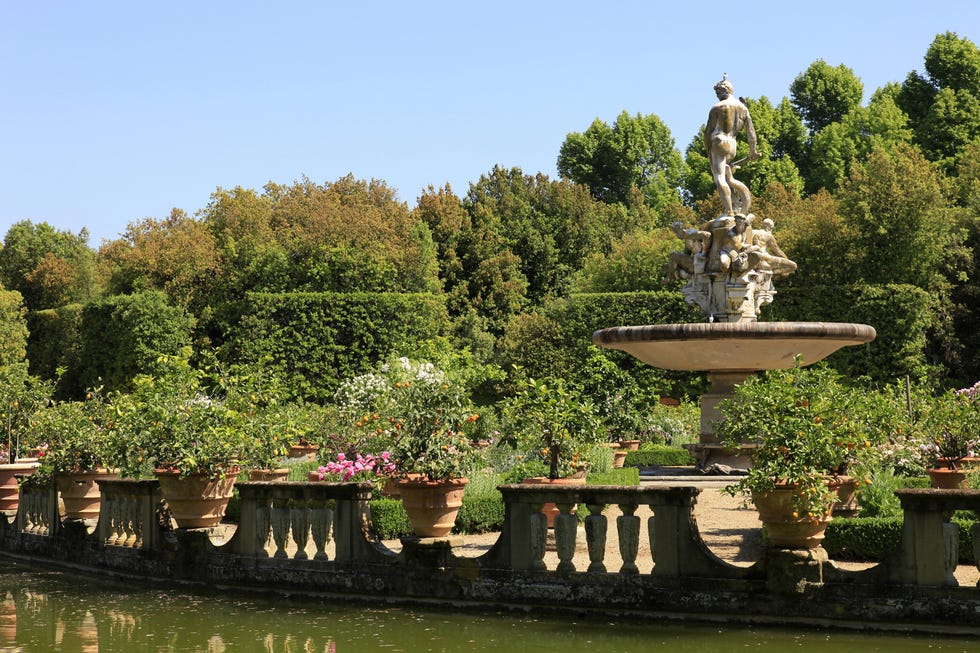
Every art history student has heard of the Uffizi and its mind-bending collection of Renaissance masterpieces. The Boboli Gardens, near the museum, are just as glorious. Located behind the Pitti Palace, the gardens follow the original layout put in place by the Medicis, the banking family that played a central role in developing Renaissance Florence. Niccolò Pericoli, known as Tribolo, began designing and planting the garden in 1549 for Eleonora de Toledo, the wife of Cosimo I de Medici. Be sure to visit the grotto designed by architect and engineer Bernardo Buontalenti, as well as the 18th-century “Lemon House,” with its historic collection of lemon trees.
Château du Champ de Bataille, Normandy, France
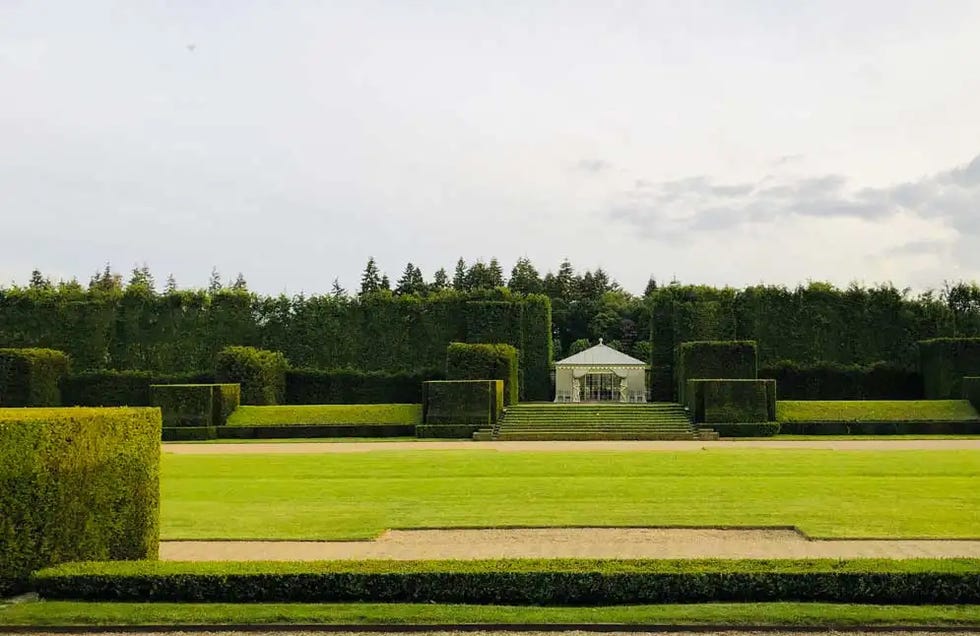
Rarely do designers get to create a gesamtkunstwerk on the scale of Jacques Garcia’s Château du Champ de Bataille in Normandy. The legendary interior designer acquired the Baroque château in the 1990s and has since overhauled every part of it, including its vast gardens. The result is a fanciful interpretation of the formal gardens French kings enjoyed for centuries. Walk through the boxwood hedges, whose layout recalls drawings of the original garden, and find your way to a magical world of grottos, ponds, pavilions, and meticulously constructed temples.
Advertisement – Continue Reading Below
Sanssouci Park, Potsdam, Germany
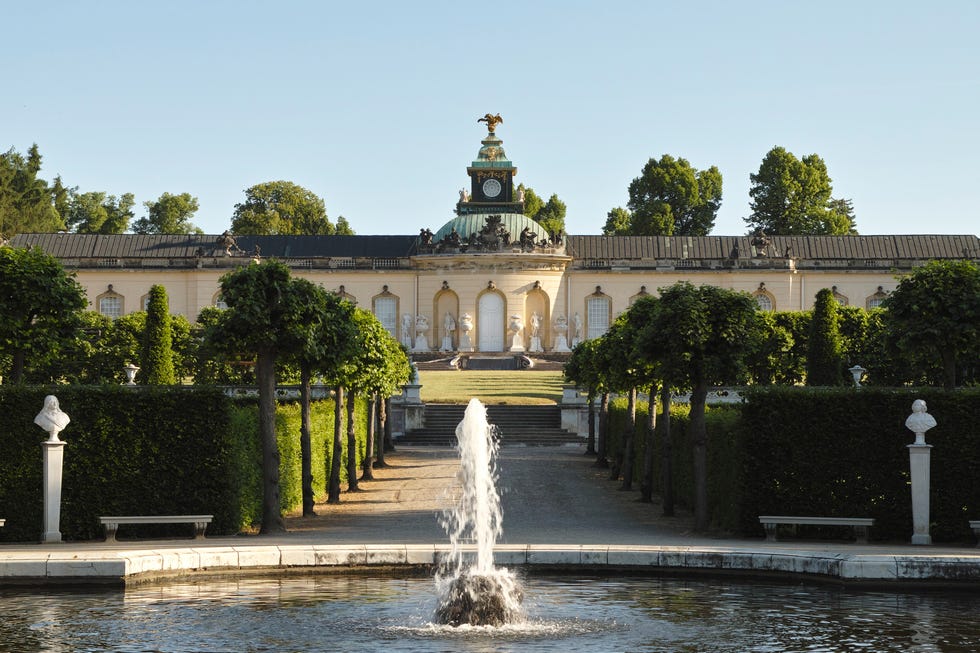
When Frederick the Great built Sanssouci Palace in the 18th century, he had a very specific vision in mind. The Prussian king had a firm rule at his pleasure palace: no female visitors. But he did welcome guests like Voltaire for long summer stays. Today women are welcomed at Sanssouci, and a highlight of any visit is a tour of the gardens. The grounds are expansive, featuring terraced gardens, hedges, and flower beds designed by Frederick himself. There is also a small park with meadows, lawns, and an orangery from Frederick William IV’s reign.
Gulbenkian Garden, Lisbon, Portugal
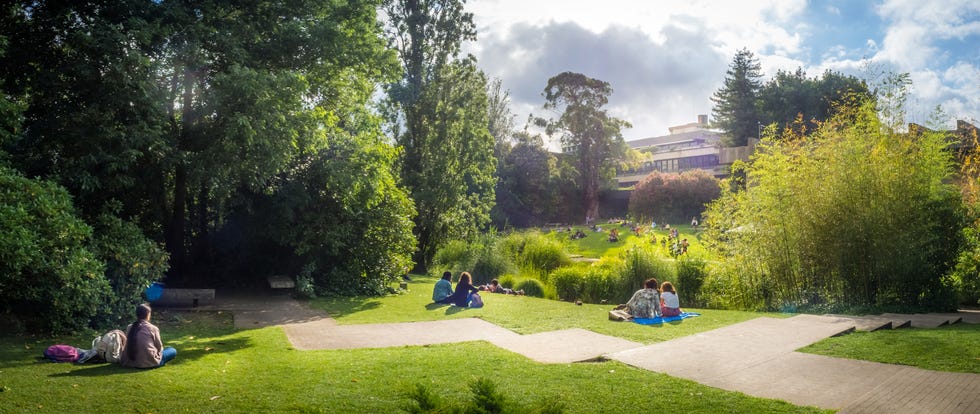
One of the best-kept secrets in Lisbon are the gardens surrounding the Calouste Gulbenkian Museum. Gulbenkian was a British-Armenian businessman and art collector who left most of his art collection and a great deal of his wealth to the museum, founded the year after his death in 1956. Ponds and tropical trees commingle in the wild, walkable landscape that surrounds the striking modernist museum, designed by Leslie Martin. More than 200 species of flower and plant proliferate in the garden, which is organized in a trapezoid, attracting birds and pollinators that the foundation keeps track of. The large surrounding park offers more to explore and a buffer against the busy city around it. If the mood strikes you, take a peek inside to see 18th-century Chinese porcelain, 16th-century Persian drawings and decorative art, or one of the museum’s many compelling exhibitions.
Advertisement – Continue Reading Below
Hameau de la Reine, Versailles, France
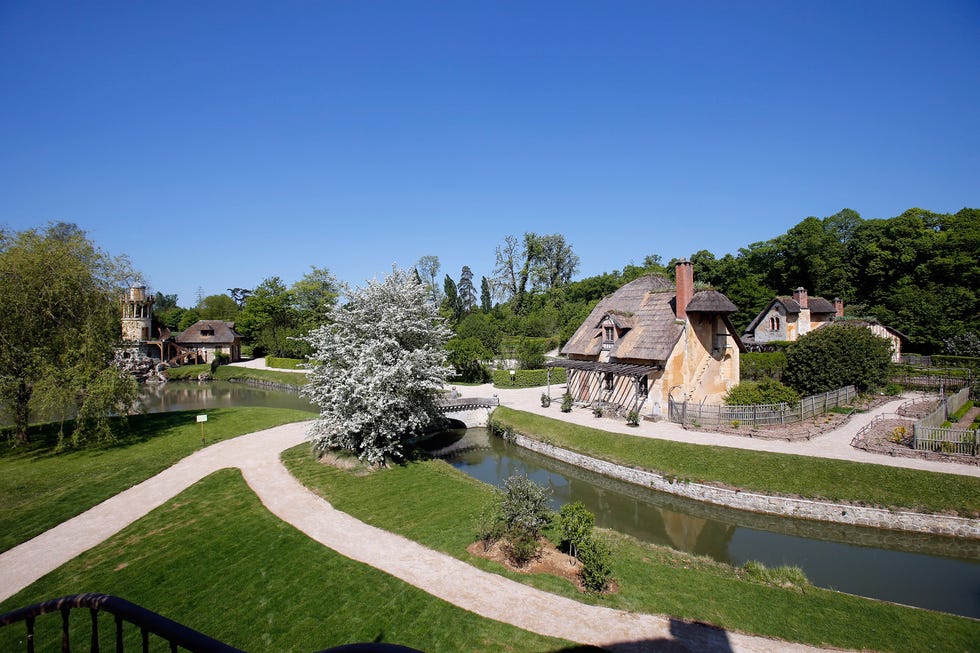
Very few of us will ever know the joy of creating a make-believe village for our own amusement, but thanks to Marie Antoinette we can at least experience one for a day. Tucked into one corner of the extensive grounds surrounding the Palace of Versailles is the doomed queen’s weekend escape, the Petit Trianon. Abutting the small manor house, Marie Antoinette had her architect, Richard Mique, design a faux village—her hameau—complete with a lake, a grotto, a windmill, and cottages. Mique even had fake cracks painted onto the walls when the structures were erected, between 1783 and 1786. Like something from the Brothers Grimm, the surrounding gardens pull you into a fairy tale—one that ended with a head in a basket.
Kenroku-en, Kanazawa, Japan
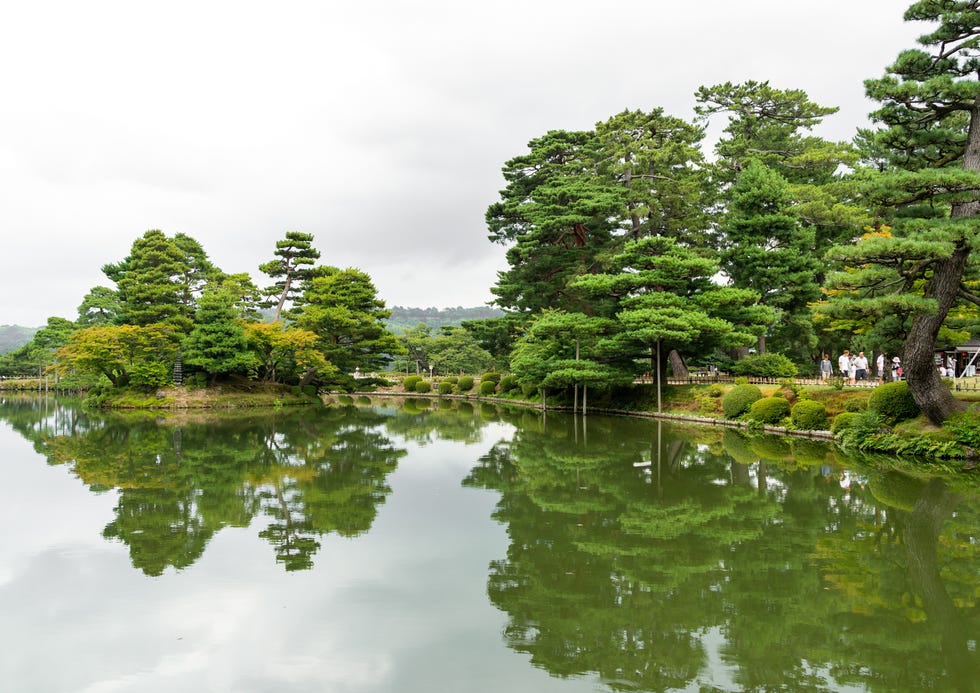
The serenity of Japanese gardens is legendary—no surprise in a place where the people have spent centuries honing a deep and respectful symbiosis with the natural world. In Kanazawa, one Edo-period garden stands out for its experiential, all-season perfection: Kenroku-en. Construction began at the behest of the powerful Maeda family in 1676 and continued for the next two centuries. It opened to the public in the 19th century and has been meticulously maintained ever since. Its twisting paths, ponds, pavilions, and tea houses cover 20 acres and boast one of the most impressive fountains in Japan. It is said the park is most beautiful in winter.
Watch Next

Advertisement – Continue Reading Below
Advertisement – Continue Reading Below
Advertisement – Continue Reading Below
